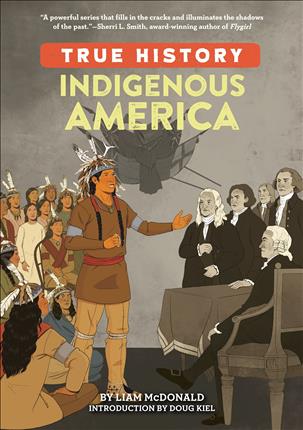| Indigenous America (True History) Author: McDonald, Liam | ||
| Price: $7.37 | ||
Summary:
American schoolchildren have long been taught that their country was "discovered" by Christopher Columbus in 1492. But the history of Native Americans in the United States goes back tens of tens of thousands of years prior to Columbus's and other colonizers' arrivals. So, what's the true history? Indigenous America introduces and amplifies the oral and written histories that have long been left out of American history books.
Full Text Reviews:
School Library Journal - 08/01/2022 Gr 4–8—A comprehensive and accessible history of the Indigenous peoples of North America. McDonald takes young readers through a tour of Native American history, debunking myths and misinformation while highlighting influential individuals who have made a lasting impact on Indigenous and North American history. Focusing on the events from before Columbus to the present day, this thorough volume pokes holes in long held beliefs, such as how the first tool-using humans migrated from Siberia 13,000 years ago; evidence has been found that Indigenous peoples have been around at least 130,000 years. From the signing of the Declaration of Independence to each conflict the U.S. has fought in, Native Americans have been a part of every aspect of American history. The work also details the horrible and methodical institutional racism, genocide, ethnocide, and erasure that they have endured at the hands of colonizers. Painful to read at times, this book illuminates not only the suffering Indigenous people experienced at the hands of the U.S. government, but also sheds light on their resilience and the impact they have made and continue to make on American culture. The narrative sometimes jumps chronologically, focusing more on themes than a specific time line. Sidebars are scattered throughout, offering definitions, context, and more to engage readers and add interest. There are also discussion questions at the end of each chapter, making this a good tool for classroom use. Images and a selected bibliography are included in the back matter. The author takes on an informal tone, speaking directly to readers, recalling the oral traditions that he emphasizes at the start. VERDICT A strong choice for middle grade collections, especially where readers are not yet ready for Roxanne Dunbar-Ortiz's An Indigenous Peoples' History of the United States for Young People.—Shelley M. Diaz - Copyright 2022 Publishers Weekly, Library Journal and/or School Library Journal used with permission.
Booklist - 07/01/2022 This addition to the True History series documents Indigenous societies that thrived in America long before Europeans showed up and declared they’d discovered a new land. Seeking to correct traditional historical records, the text traces the history of Native Americans from prehistoric times through the development of democratic societies and cooperative confederations to the nineteenth-century genocide inflicted by the American government. Instead of a straight chronological approach, chapters revolve around Native American creation stories and myths, effectively emphasizing the richness of Indigenous oral histories. There are references to Native influences on American culture, with special detail paid to music and musicians. Closing chapters review twentieth-century Native American activism and recent efforts by government agencies and educational institutions to increase Indigenous representation (identifying the tribal lands their campuses occupy, updating Eurocentric Thanksgiving rhetoric, eliminating offensive language and mascots that demean Indigenous peoples). Quotes, vocabulary definitions, and discussion prompts appear throughout the pages; back matter includes a selected bibliography, photos, and other graphics. There are no chapter notes or references, alas, but lots to ponder. - Copyright 2022 Booklist.
Booklist - 07/01/2022 This addition to the True History series documents Indigenous societies that thrived in America long before Europeans showed up and declared they’d discovered a new land. Seeking to correct traditional historical records, the text traces the history of Native Americans from prehistoric times through the development of democratic societies and cooperative confederations to the nineteenth-century genocide inflicted by the American government. Instead of a straight chronological approach, chapters revolve around Native American creation stories and myths, effectively emphasizing the richness of Indigenous oral histories. There are references to Native influences on American culture, with special detail paid to music and musicians. Closing chapters review twentieth-century Native American activism and recent efforts by government agencies and educational institutions to increase Indigenous representation (identifying the tribal lands their campuses occupy, updating Eurocentric Thanksgiving rhetoric, eliminating offensive language and mascots that demean Indigenous peoples). Quotes, vocabulary definitions, and discussion prompts appear throughout the pages; back matter includes a selected bibliography, photos, and other graphics. There are no chapter notes or references, alas, but lots to ponder. - Copyright 2022 Booklist.


